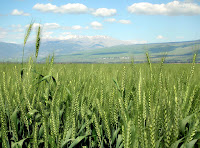For a crop that looks so homogeneous, there's an awful lot of diversity in wheat.
Two major species are grown in the U.S. - common bread wheat (Triticum aestivum) and durum wheat (T. durum) - with little to no cultivation of more primitive einkorn, emmer and spelt species.
Durum wheat is used to make semolina flour (for pasta), and (in the U.S.) is pretty much just grown in North Dakota. In the past, this crop was intentionally exposed to radiation (mutation breeding) in order produce novel genetic variation. The resulting mutation improved pasta quality.
Common bread wheat is commonly classified as hard or soft, red or white and winter or spring. As with all crops, the quality of the final product is heavily influenced by the genetics and the environment responsible for a given harvest. Accordingly, mills commonly choose their varieties carefully and mix batches grown in different fields to balance out the chemistry of the final product.
In general, hard wheat has lots of protein and is used for hard baked goods (e.g. bread) while soft wheat has more starch and is used for soft baked goods (e.g. pastries). Red and white wheat, as you might guess, produce flour with different colors.
The five major classes of wheat grown in the U.S. are largely divided by geography: west of the Mississippi (hard red winter and hard red spring for bread), east of the Mississippi (soft red winter for pastries), white (Pac NW and New England/NY for bread) and durum (ND for pasta).*
Winter and spring wheat differ in vernalization. Winter varieties won't flower until they've experienced a sufficiently long cold period, while spring wheat varieties flower as soon as they can. As wheat has broad natural variation in vernalization requirements, cultures all over the world have independently selected "winter" and "spring" versions of their favorite varieties.
In the coldest climates (e.g. Montana and Washington), spring wheat is planted in the spring. Without any vernalization requirements, the crop rushes to flower and set seed before the short summer ends. In more moderate climates (e.g. Kansas), winter varieties are planted in the fall, where they germinate and grow a little before the winter sets in. Vernalization requirements keep these plants safely dormant over the winter, and this head start allows them to produce superior yields during the following summer. In the hottest and driest climates (e.g. California), spring wheat is planted in the fall. The plants rush to flower during the adequately warm and wet winter, and are harvested before lethal summer droughts set in.
Initiation of flowering is a very complex process that is influenced by many genetic and environmental factors (e.g. it can be sped up in a pot-bound plant and delayed with excessive nitrogen). Vernalization adds another layer to this complexity in wheat. A whole series of regulatory molecules have been discovered in wheat that contribute quantitatively to "locking down" the pathway that leads to flowering or alternatively "picking the lock," releasing the plant to flower. A variety of assorted "lock" and "pick" components of varying strengths exist within wheat germplasm, giving individual varieties unique levels of inhibition to flowering.
It's pretty fascinating how complicated biology can be when you really start to understand the details
*According to Logsdon, Small-scale grain raising


We're lucky to have an excellent local flour mill. The flours are all packaged in plain 5lb brown paper sacks and are labeled with exactly what wheat is in them. It is a lot of fun to experiment with a recipe by varying the amount of red and white or hard and soft flours in a mix and seeing how it effects the final product. Also, their unbolted corn meal makes the best corn bread. (Unbolted corn meal hasn't been sifted so it still contains larger pieces of the kernel husk.)
ReplyDeleteCool, thanks for the lesson on wheat!
ReplyDeleteThat sounds really fun! How does the corn bread made from unbolted meal differ from bolted?
ReplyDeleteThe unbolted corn meal definitely has a more pronounced "corn" flavor than the bolted/sifted meals. It also seems to bake into a cornbread that is slightly more toothsome. It seems to bake up moister with larger air pockets, whereas the bolted corn meal (probably owing to the much smaller and more uniform particle size)seems to bake into a finer crumb. In polenta and mush the unbolted meal makes the dish a little less starchy/gummy.
ReplyDeleteIts' worth noting that the unbolted corn meal does not keep as long, but owing to all the extra fiber from the hull it is a lot healthier.
Here's our local mill, and all of the flours they have available. I also have some winter rye in our backyard leftover from a winter cover crop I neglected to cut down. I might have enough to make a few cups of flour in a few weeks, if I'm willing to grind it all in my coffee grinder